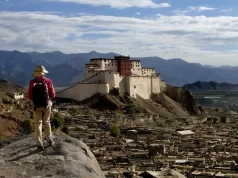One of the best things about scuba diving is the friendships. Some last only for a single shared dive, while others last a lifetime. But, what makes diving even more special is when you meet women in scuba who open your eyes to an entirely new way of looking at the ocean, and in some cases, yourself.
That’s exactly what happened while consciously exploring the Maldives. After over a year of planning, we were on our way to the remote Raa Atoll, situated near the more well-known neighbor, Baa Atoll. Famous for its UNESCO Biosphere Reserve, Hanifaru Bay, Baa Atoll is notorious for hosting one of the largest manta aggregations on the planet. You’ve certainly seen this bay when the manta action is firing, as many of the stunning reels and photos you see of mantas come from this magical place on earth.
But right next door, on Raa Atoll, there’s sometimes even more action happening, especially if you’re there for a full moon cycle. That’s why the Manta Trust, a nonprofit dedicated to the research and understanding of mantas and their relatives, is strategically stationed here conducting new research on this sometimes forgotten atoll.
Not only did we want to go to see manta rays thriving in their natural habitat, but we also wanted to meet the team pushing for their survival and the success of an island nation that is heavily impacted by the climate crisis. With the Maldives being almost entirely water, the effects of climate change, if not addressed, could be catastrophic for this island nation.
It’s estimated that by 2050, a vast majority of the Maldives could be rendered uninhabitable due to rising sea levels. Meaning 80% of the nation would become submerged, with not a single island above sea level. Floating islands and developments have been tested around the capital city, Malé as a long-term solution. But, according to the locals, there really isn’t a full-proof plan in place.
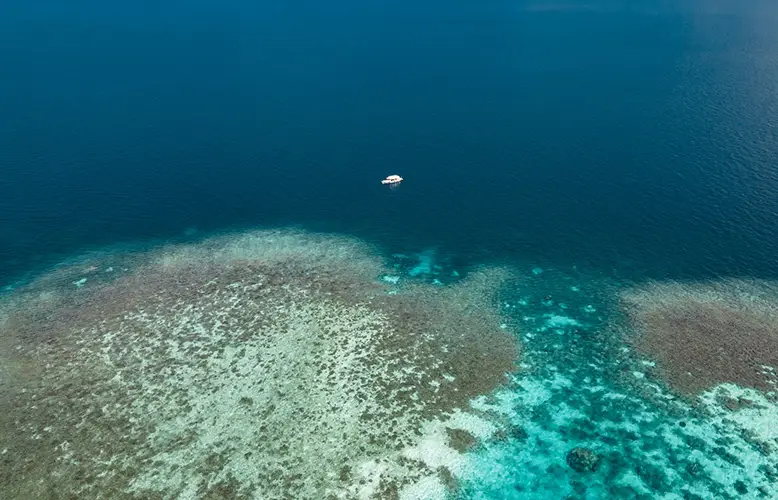
The Maldives run on tourism, especially the luxury variety. That’s why properties throughout the Maldives are catching on to the fact that they need to earnestly consider how they will contribute to protecting their little slice of paradise. One property in particular is going the extra mile by basing the Manta Trust team on-site. And that’s where our team was headed for a week to learn from the pros and spend our days out on their research vessel.
Arriving at the InterContinental Maldives Maamunagau Resort, we were greeted by Meral Hafeez and Emily Hoad, two of the Manta Trust’s project managers appointed to look after Raa Atoll. Welcoming us with open arms, they were eager to give us a front row seat to observe their conservation work in action, made possible due to their strategic alignment with this breathtaking resort.
Emily’s Charismatic Mantas
When it comes to understanding mantas, Emily is your go to. Any fact, question, or stat, she’s got it down. Working onsite for the last three years, the passion exudes out of this one from the second you meet her. If there’s anyone in the world that’s going to get you excited about mantas, it’s Emily.
She explained to us that mantas are called “gateway” or “flagship” species. With their graceful movements and grand wingspans, they are often described as charismatic megafauna, capturing the hearts and imaginations of many who encounter them. Their gentle nature, combined with their intelligence—evident in their large brain relative to body size—makes them intriguing subjects for both scientific study and ecotourism.
Manta rays engage in fascinating behaviors such as barrel rolls and “train” formations when feeding, and their curious nature can lead them to approach and interact with divers. Beyond their mesmerizing presence, mantas play a critical role in marine ecosystems, particularly in nutrient cycling.
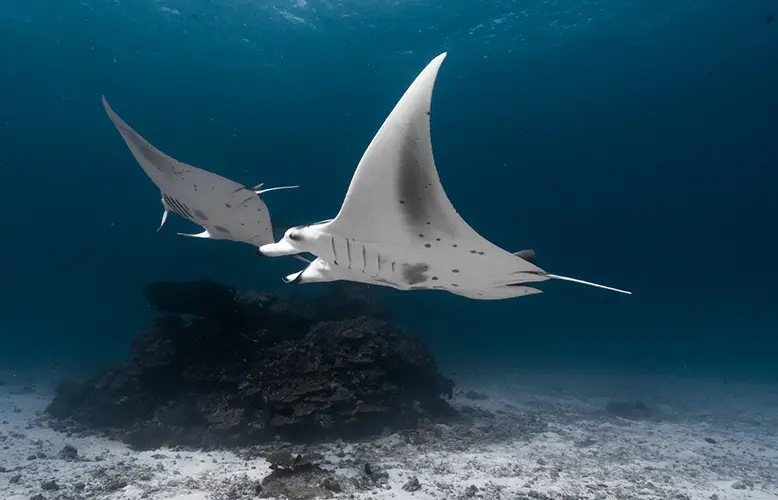
As filter feeders, they consume large quantities of zooplankton, which helps in maintaining balance within the marine food chain. While their status on the food chain makes them vital for the marine biodiversity in the area, their unique and striking appearance draws attention to the broader conservation needs of these kinds of marine habitats. Basically, mantas have dual roles they play—one on behalf of the ocean and one when it comes to us.
This is one of the reasons Emily fell in love with mantas in the first place, bringing her to the nonprofit to further her career. We couldn’t help but ask how she landed a dream job for many in the conservation space, getting the rare opportunity to observe, monitor and study mantas during many peak seasons in Raa Atoll.
For her, it was a matter of putting herself in the right places at the right time—and also realizing that she needed to start somewhere. Born in Hong Kong, her family relocated her to Dubai. Deciding to study marine biology at university in the UK, she took the first role she could get at the Atlantis Aquarium in the UAE, helping with turtle and coral restoration.
Getting some experience in hospitality and conservation under her belt, she felt the next move was to shift to a property that was focusing on sustainability. And so, her next chapter led her to the Marine Savers at the Four Seasons Resort as a tour operator and sustainability educator, which ultimately led her to land a role with the Manta Trust at one of their newer bases in the Maldives.
Her inherent curiosity has not only landed her jobs, but has also driven her to unravel how things function, both in the lab and in the field. For Emily, the crux of her work revolves around harnessing research and data to discern intricate patterns and trends within marine ecosystems. One of her fervent passions lies in demystifying the inherent elusiveness of manta rays. She’s on a quest to delve into their behaviors, aiming to better understand what influences them—from environmental factors like pollution and overfishing to their natural food sources.
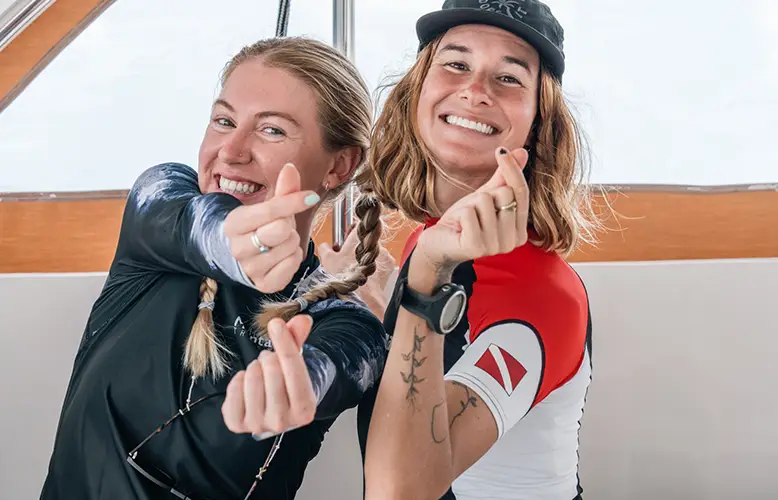
Despite her experiences thus far, Emily believes she’s still scratching the surface of her career. While reef mantas initially opened the door to this underwater world, her thirst for discovery has only intensified. She would gush to us over her dream of one day becoming an aquanaut, diving into uncharted depths to unveil marine enigmas. This drive is even more pressing when considering that a mere 8% of the deep sea has been explored.
For Emily, every day out on the water is one step closer to the answers she’s constantly craving. And mantas are HER gateway to exploring this blue, vast unknown.
Getting Deep with Meral
While Emily shared her love of mantas and going deep, the Manta Trust Raa Atoll Teal Lead, Meral, got deep with us in a different way. Her extremely holistic perspective was born out of a massive career overhaul. Hailing from Toronto, Canada, Meral was on track to becoming a lawyer. Despite appreciating the subject’s essence, she struggled with its practicality and felt a certain calling for the ocean as she worked her way through law school.
Upon graduation, this internal conflict led her into a tumultuous period of soul-searching. She grappled with the idea of letting go of her invested efforts in a legal career and upending her life to pursue marine conservation. During this time of deep contemplation, she sought solace in Florida, where the ocean not only provided her with a sense of peace but also reignited her intrinsic curiosity.
That curiosity landed her in Thailand to get more involved with reef restoration. While there, it was a requirement for her to learn scuba to do the work. In a short period of time, Meral completed open water, advanced and rescue diving certifications consecutively. It was here that she also learned about coral restoration diving, a task so moving that she recalled being overcome with emotion when planting her first piece of coral. After that moment, she realized a career in ocean conservation and restoration was in fact the only way for her.
This led her to the Maldives, where she assumed the role of an ocean guardian at the ultra-luxury Soneva Resort. Eager to make a difference, Meral aspired to transform the typical vacationer’s ocean experience into a profound understanding of corals. When she learned of the Manta Trust’s systems approach, and how the team leveraged mantas to open people’s eyes to the power of the entire ecosystem, she decided to make her next career shift.
When she speaks of a “systems approach”, she is alluding to a holistic way of understanding and addressing the multifaceted intricacies of the marine world. The ocean is not just a collection of individual entities and ecosystems, but a dynamic web of interdependent relationships. Every organism, from the tiniest plankton to the largest manta ray, plays a role in maintaining the balance and health of the marine ecosystem.
Taking a systems approach means acknowledging that each component of the ocean—its currents, temperatures, marine species and even the human activities on its shores—is intertwined. When one element is disrupted, it can lead to a cascade effect throughout the system. Meral explained that if we disregard coral, that means we are disregarding the mantas as well.
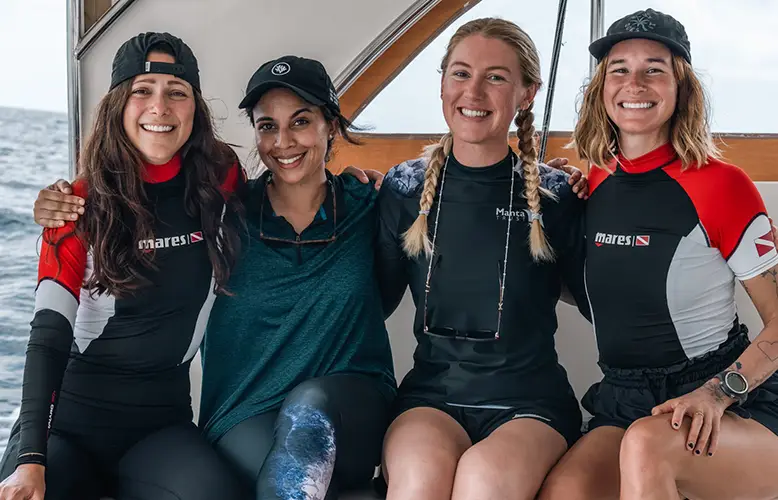
Although the mantas might be more exciting for a diver to see, the infrastructure that keeps the mantas in this habitat are in fact the coral colonies that the whole of the marine world relies on. Destroying coral can destabilize food chains, alter the larger ecosystem and even affect the livelihoods of coastal communities.
From Meral’s view, it’s imperative that when considering conservation and preservation efforts, we don’t zero in on just one aspect, but rather embrace the marine environment in totality. Meaningful change in conservation isn’t just about protecting a single flagship species, such as mantas, or addressing an issue in isolation. It’s about understanding and working with the entirety of the system, understanding the sum of all parts. This holistic view ensures that solutions are not only effective but also sustainable in the long run.
It’s this expansive and interconnected mindset that drew Meral to the Manta Trust, enabling her to put the theory into practice—something she couldn’t see herself doing in a legal career. At the heart of the Manta Trust, just like Meral’s philosophy, lies the conviction that true conservation requires thinking as big as possible.
But That’s Not All
Deep and meaningful conversations didn’t just happen with Meral and Emily. We also went there with Svenja Rehbein, the PR & Marketing Communications Director at Intercontinental Maamunagau Resort. Our long, late night conversations touched on hospitality’s shift toward sustainability, the Maldives’ past focus exclusively on divers, the rise in tourism over the last decade, and ways to sustain this special island’s essence.
And with those late night convos, more women in hospitality came to the table to share how they were connecting their profession to worldly contribution. Each woman expressed their desire to use their skills and expertise to help enable better exploration of the blue planet—from women working in human resources to public relations to marine sciences.
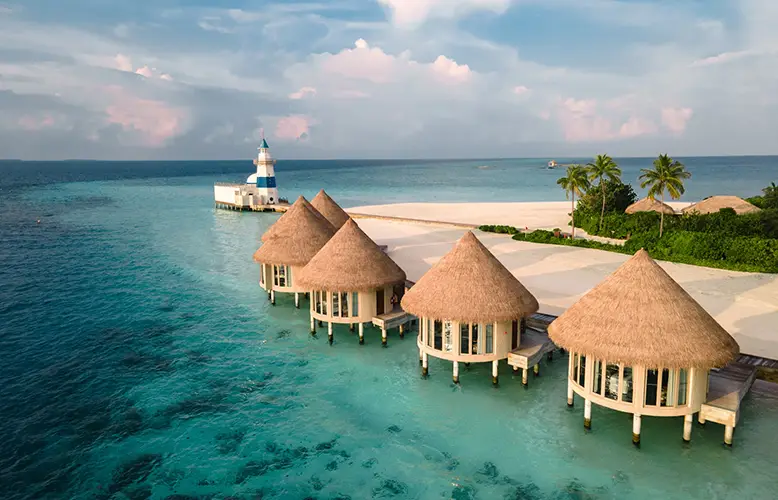
These talks highlighted the bond among women, united by a genuine respect and appreciation for the ocean. Simply put: sitting around this table of mission-driven women, varying in age, background and expertise, was incredible. And what going to the edges of earth is all about.
Departing the Maldives, we carried with us more than memories of the majestic mantas, the stunning ocean views, and the unparalleled luxury of Maamunagau that we enjoyed calling “home” for a period of time. We left moved by the unwavering dedication of the remarkable ocean champions we encountered. Their shared narrative is now shaping every upcoming phase of our expedition, pushing us to think even bigger than we were before.


